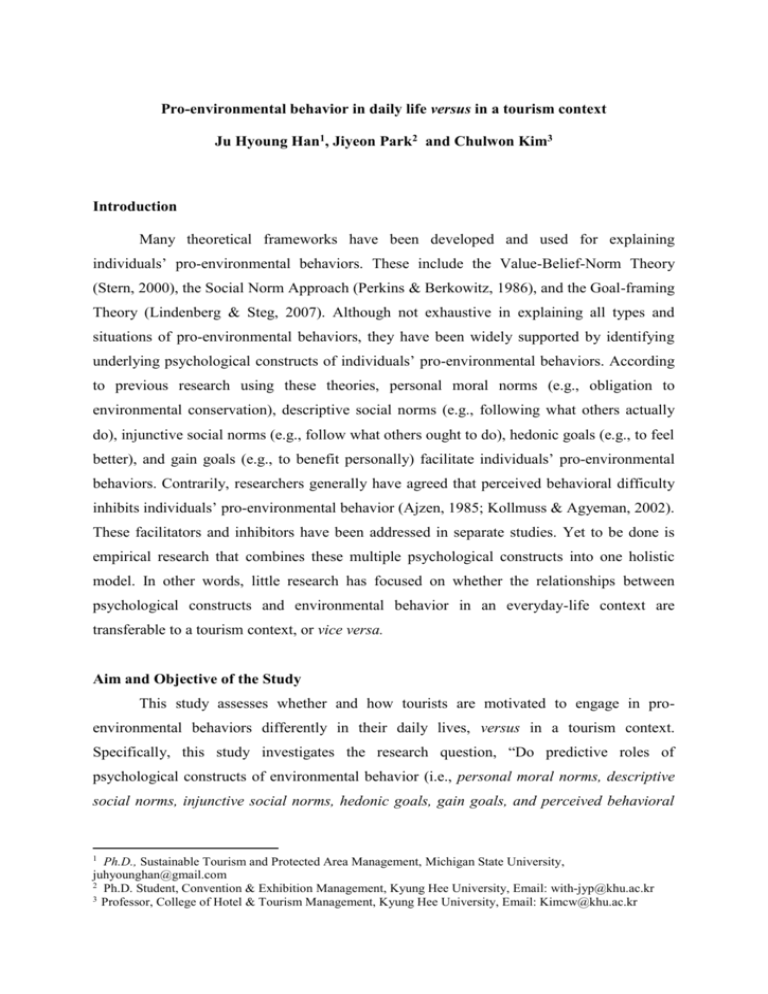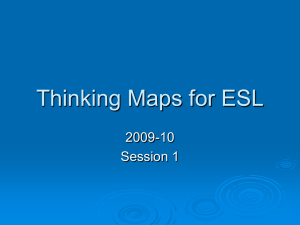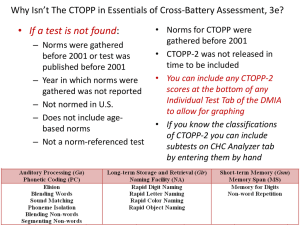Pro-environmental behavior in daily life versus in a tourism context
advertisement

Pro-environmental behavior in daily life versus in a tourism context Ju Hyoung Han1, Jiyeon Park2 and Chulwon Kim3 Introduction Many theoretical frameworks have been developed and used for explaining individuals’ pro-environmental behaviors. These include the Value-Belief-Norm Theory (Stern, 2000), the Social Norm Approach (Perkins & Berkowitz, 1986), and the Goal-framing Theory (Lindenberg & Steg, 2007). Although not exhaustive in explaining all types and situations of pro-environmental behaviors, they have been widely supported by identifying underlying psychological constructs of individuals’ pro-environmental behaviors. According to previous research using these theories, personal moral norms (e.g., obligation to environmental conservation), descriptive social norms (e.g., following what others actually do), injunctive social norms (e.g., follow what others ought to do), hedonic goals (e.g., to feel better), and gain goals (e.g., to benefit personally) facilitate individuals’ pro-environmental behaviors. Contrarily, researchers generally have agreed that perceived behavioral difficulty inhibits individuals’ pro-environmental behavior (Ajzen, 1985; Kollmuss & Agyeman, 2002). These facilitators and inhibitors have been addressed in separate studies. Yet to be done is empirical research that combines these multiple psychological constructs into one holistic model. In other words, little research has focused on whether the relationships between psychological constructs and environmental behavior in an everyday-life context are transferable to a tourism context, or vice versa. Aim and Objective of the Study This study assesses whether and how tourists are motivated to engage in proenvironmental behaviors differently in their daily lives, versus in a tourism context. Specifically, this study investigates the research question, “Do predictive roles of psychological constructs of environmental behavior (i.e., personal moral norms, descriptive social norms, injunctive social norms, hedonic goals, gain goals, and perceived behavioral 1 Ph.D., Sustainable Tourism and Protected Area Management, Michigan State University, juhyounghan@gmail.com 2 Ph.D. Student, Convention & Exhibition Management, Kyung Hee University, Email: with-jyp@khu.ac.kr 3 Professor, College of Hotel & Tourism Management, Kyung Hee University, Email: Kimcw@khu.ac.kr difficulty) differ in predicting tourists’ pro-environmental behavior in daily life versus in the context of tourism?” Methodology and Data To administer on-site surveys, 6 paid survey-administrators were assigned, one to each of six zones. Systematic sampling procedure started at a set location within each designated tailgating zone. Each administrator invited the four closest adult tailgaters (18 or older) to complete, each, an on-site questionnaire and requested them to participate in followup online or mail survey. Once that was done, the administrator moved to the next proximate group and repeated the procedure and the requests. Of the 1,468 intercepted tailgaters, 514 (35%) surveys were collected. Prior to analyzing the data, out of 514 surveys collected, eight responses were dropped because the majority of the questionnaire was incomplete. Another 101 surveys were dropped because they were inappropriate for analyses; they did not provide comparable responses. For example, although an answer choice option “don’t use” was intentionally included in behavior measurement scales to reduce measurement error, those responses were not appropriate when comparing paired responses. Resultantly, 405 useable responses were available for further analyses. Results The main purpose of the study was to develop and test models to understand and compare how individuals are motivated to engage in pro-environmental behavior in their daily lives versus in a tourism context. Results supported the idea that underlying mechanisms of pro-environmental behavior differ between two settings. Specifically, the first regression model suggested that personal moral norms, hedonic goals, and perceived behavioral difficulty, affect pro-environmental behavior in daily life; these effects were independent of any effects of age, gender, and habitual environmental behavior, as controlled for in the analysis. The second regression model suggested that descriptive social norms as an underlying motive contributed significantly to the variance of pro-environmental behavior in a tourism context, after controlling for age, gender, and habitual environmental behavior. The first regression analysis indicated that personal moral norms and perceived behavioral difficulty were underlying motives of pro-environmental behaviors in daily life. This finding is consistent with those reported in other studies (e.g., Andersson & von Borgstede, 2010; Do Valle, Rebelo, Reis, & Menezes, 2005; Ramayah, Lee, & Lim, 2012; Sidique, Lupi, & Joshi, 2010, for recycling behavior). Together with previous literature this study suggests that the Norm Activation Model and Value-Belief-Norm theory appear successful in explaining the role of personal moral norms as a mechanism of proenvironmental behavior in a daily life setting. Another stream of previous research explains that the explanatory power of personal moral norms in environmental behavior engagement becomes insignificant when behavior change is costly in terms of effort, inconvenience, money, or time (e.g., Guagnano et al., 1995; Diekmann & Preisendörfer, 2003). Where recycling at home is generally considered a “low-cost” behavior (Diekmann & Preisendörfer, 2003), the same behavior in a tourism context may require increased effort and become a “high-cost” action. Therefore, the previous research is supported that personal moral norms and perceived behavioral difficulty are underlying mechanisms of environmental behavior when the behavior is “low cost.” Another finding from the first regression analysis is that hedonic goals also play an important role in predicting environmental behavior in individuals’ daily lives. In environmental behavior research, relationships between affect and environmental behavior have been addressed in studies (e.g., De Young, 1986; Hartmann & Apaolaza-Ibáñez, 2008; Vining & Ebreo, 1990). Still, empirical findings about hedonic goals as underlying mechanisms of environmental behavior are inconclusive. Some researchers found that emotional motive relates significantly to environmental behavior, even when moral norms are controlled for (e.g., Smith, Haugtvedt, & Petty, 1994). Other researchers discuss that emotional benefit affects environmental behavior only when that behavior is difficult to undertake. In a continuing discussion about hedonic goals in predicting environmental behavior, this finding supports that they are important underlying motives of proenvironmental behavior in daily life, even after controlling for personal moral norms and perceived behavioral difficultly. The present study provides strong empirical evidence that individuals’ decisions about pro-environmental behavior are influenced by different underlying motives, as the Goal-framing theory addresses. This study expands upon previous literature on environmental behavior studies by integrating and testing multiple motivational goal frames in a single model. Further, the first regression result suggests that subjects internalize norms. In the first regression model, hedonic goals explain variance in pro-environmental behavior in daily life, in addition to personal moral norms. This suggests that personal moral norms and hedonic goals are distinct motives yet lie on the continuum of norm internalization. Deci and Ryan (1985) provide insight with their self-determination theory suggesting that an individual’s motives underlying behavior progress from extrinsic to intrinsic along a continuum. Intrinsically motivated behavior is for the sole pleasure and satisfaction derived from its practice. Extrinsically motivated behavior is for instrumental reasons, again further specified from self-determined extrinsic motivation (e.g., personal moral norms) to non-selfdetermined extrinsic motivation (e.g., regulation, incentives). Applying the logic of this continuum to the environmental behavior domain, easy pro-environmental behaviors are predicted by a relatively low level of self-determination (i.e., motives toward the intrinsic end), whereas more difficult behaviors are predicted by higher levels of self-determination (i.e., motives toward the extrinsic end) (Green-Demers, Pelletier, & Ménard, 1997; Pelletier et al., 1998). This study finding offers plausible explanation of the continuum of norm internalization. In other words, it is logical to expect that predictive powers of both personal moral norms and hedonic goals on environmental behavior are likely to be observed together if recycling behavior at home is determined by motives at the intrinsic end on a continuum. Results of the second regression suggest that descriptive social norms significantly influence environmental behavior in a tourism context yet not in daily life settings. Alternatively, personal moral norms, hedonic goals, and perceived behavioral difficulty do not significantly affect environmental behavior in a tourism context. This finding is noteworthy because different types of norms have distinct roles in predicting environmental behavior across two settings. Researchers have recognized different types of norms (Deci & Ryan, 1985; Park & Smith, 2007; Perkins & Berkowitz, 1986; Thøgersen, 2006), and different norms have been studied in separate behavioral and contextual domains. Some researchers focus on personal moral norms to explain environmental behavior (e.g., Nordlund & Garvill, 2002; Schwartz, 1977; Stern, 2000; Turaga, Howarth, & Borsuk, 2010), whereas others focus on social norms to understand environmental behavior (e.g., Cialdini et al., 2006; Goldstein et al., 2008; Nolan et al., 2008; Perkins & Berkowitz, 1986). This study generated additional understanding of environmental behavior by integrating multiple motives adapted by the Goal-framing theory and the Social Norm Approach. Empirical support was provided regarding that different types of norms exist together within individuals yet have different roles in predicting their environmental behaviors, depending on settings where the action occurs. Arguably the present study’s significant finding is that three constructs—personal moral norms, hedonic goals, and perceived behavioral difficulty—were found to have significant effect on environmental behavior in the daily life setting, but not in the sport event setting. This suggests that underlying mechanisms of environmental behavior differ across settings. As this study first attempts to explore different mechanisms of the same environmental behavior between daily life and in a tourism context, further discussion involves possible explanations of this finding based on theoretical understanding. The goal-frame theory helps better understanding of environmental behavior. Central idea of the theory is that goals govern or “frame” what knowledge and attitudes become cognitively most accessible. As regression analyses showed, descriptive social norms dominate in influencing environmental behavior in the event tourism setting, whereas personal moral norms and hedonic goals dominate in affecting environmental behavior in the daily life setting. When individuals are at a sport event or in a tourism context, this setting influences what they think of at the moment, what information they are sensitive to, what action alternatives they perceive, and how they act. Attaching socialization meaning to tailgating activity, individuals in such settings may make certain associations about their descriptive social norms and environmental behavior in their focus on “social frame.” Under this frame in sport event settings, tailgaters may have weak association with their moral norms and environmental behavior, and act accordingly. References Ajzen, I. (1985). From intentions to actions: A theory of planned behavior. In J. Kuh and J. Beckmann (Eds.), Action control: From cognition to behaviour (pp. 11-39). Berlin: Springer-Verlag. Anderson, J. C., & Gerbing, D. W. (1988). Structural equation modeling in practice: A review and recommended two-step approach. Psychological bulletin, 103(3), 411. De Young, R. (1986) Encouraging environmentally appropriate behavior: The role of intrinsic motivation. Journal of Environmental Systems, 15(4), 281-292. Diekmann, A., & Preisendörfer, P. (2003). Green and Greenback The Behavioral Effects of Environmental Attitudes in Low-Cost and High-Cost Situations. Rationality and Society, 15(4), 441-472. Do Valle, P. O., Rebelo, E., Reis, E., & Menezes, J. (2005). Combining behavioral theories to predict recycling involvement. Environment and Behavior, 37(3), 364-396. Drenten, J., Peters, C. O., Leigh, T., & Hollenbeck, C. R. (2009). Not just a party in the parking lot: An exploratory investigation of the motives underlying the ritual commitment of football tailgaters. Sport Marketing Quarterly, 18(2). 92-106. Dunlap, R. E., & Van Liere, K. (1978). The new environmental paradigm. Journal of Environmental Education, 9, 10-19. Guagnano, G. A., Stern, P. C., & Dietz, T. (1995). Influences on attitude-behavior relationships: A natural experiment with curbside recycling. Environment and behavior, 27(5), 699-718. Hartmann, P., & Apaolaza-Ibáñez, V. (2008). Virtual nature experiences as emotional benefits in green product consumption. Environment and Behavior, 40(6), 818-842. James, J., Breezeel, G. S., & Ross, S. (2001). A two-stage study of the reasons to begin and continue tailgating. Sport Marketing Quarterly, 10(4), 212-222. Kaiser, F. G. (2006). A moral extension of the theory of planned behavior: Norms and anticipated feelings of regret in conservationism. Personality and Individual Differences, 41(1), 71-81. Kaiser, H. F. (1960). The application of electronic computers to factor analysis. Educational and Psychological Measurement, 20, 141-151. Kline, R. B. (1998). Principles and practice of structural equation modeling. Guilford, New York. Kollmuss, A., & Agyeman, J. (2002). Mind the gap: Why do people act environmentally and what are the barriers to pro-environmental behavior? Environmental Education Research, 8(3), 239-260. Lindenberg, S., & Steg, L. (2007). Normative, gain and hedonic goal frames guiding environmental behavior. Journal of Social Issues, 63(1), 117-137. Nordlund, A. M., & Garvill, J. (2002). Value structures behind proenvironmental behavior. Environment and Behavior, 34(6), 740-756. Perkins, H. W., & Berkowitz, A. D. (1986). Perceiving the community norms of alcohol use among students: Some research implications for campus alcohol education programming. International Journal of The Addictions, 21, 961–976. Ramayah, T., Lee, J. W. C., & Lim, S. (2012). Sustaining the environment through recycling: An empirical study. Journal of Environmental Management, 102, 141-147. Sidique, S. F., Lupi, F., & Joshi, S. V. (2010). The effects of behavior and attitudes on dropoff recycling activities. Resources, Conservation and Recycling, 54(3), 163-170. Stern, P. C. (2000). New environmental theories: Toward a coherent theory of environmentally significant behavior. Journal of Social Issues, 56(3), 407-424. Stern, P. C., Dietz, T., Abel, T., Guagnano, G. A., & Kalof, L. (1999). A value-belief-norm theory of support for social movements: The case of environmentalism. Human Ecology Review, 6(2), 81-95. Vining, J., & Ebreo, A. (1992). Predicting recycling behavior from global and specific environmental attitudes and changes in recycling opportunities. Journal of Applied Social Psychology, 22(20), 1580-1607.








